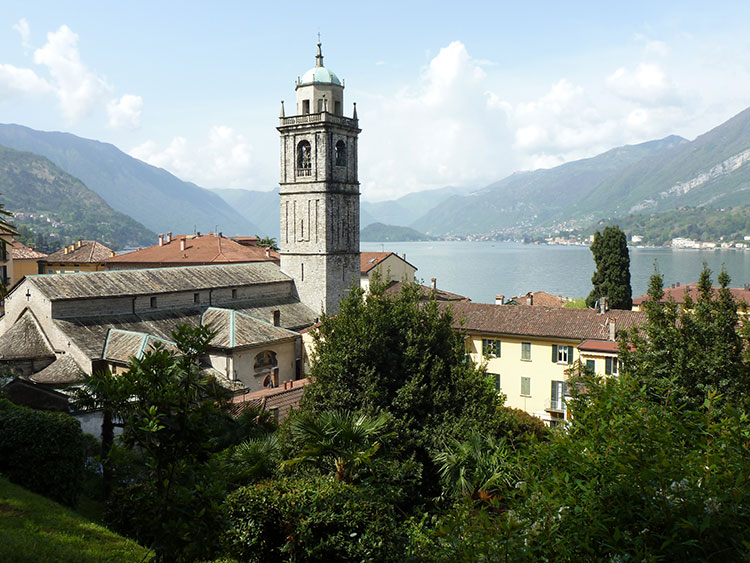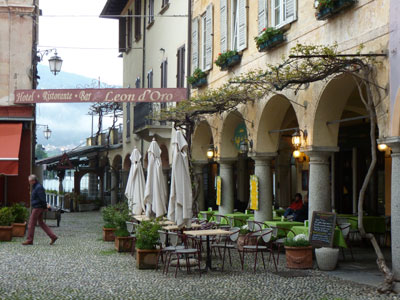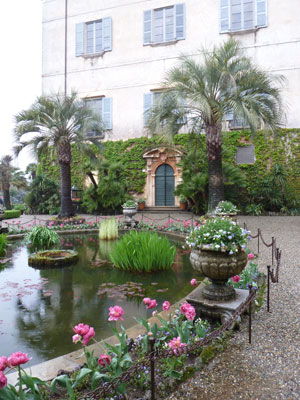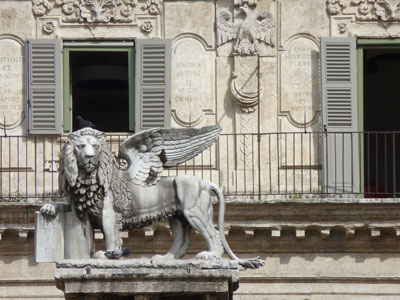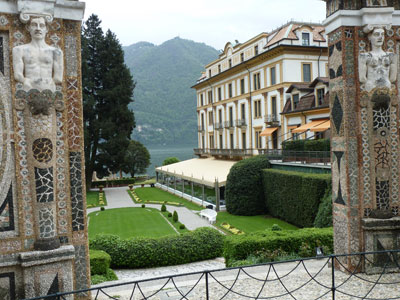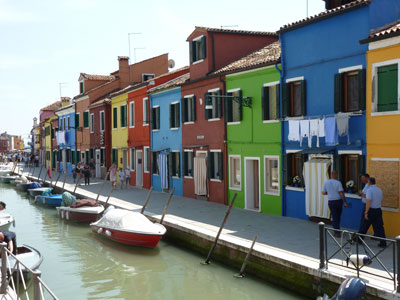Enjoying the beauty of the lakes and lagoons of northern Italy on a 12-night escorted tour
This article appears on page 6 of the September 2013 issue.
By Beth Habian, Features Editor
Many travelers seek out new destinations and new experiences in an attempt to satisfy the wanderlust that, for some, begins building the day they recover from the jet lag of their latest overseas adventure. But sometimes a particular area of the world keeps calling you back. Whether by design or happenstance, you find yourself returning to surroundings at once familiar and foreign. That place, for me, is Italy.
I’m not sure what it is, exactly, but when I’m in Italy I feel at home. So when George Nevin of Intimate France asked if I’d like to join his April 28-May 10, 2013, “Italian Lakes & Venice” tour, there was no question what my answer would be.
I had traveled with George to the Dordogne region of France in 2009 (Sept. ’09, pg. 6), and that tour still sits at the top of my list of all-time-favorite trips. But, as the company’s name suggests, France is a country with which George is intimately familiar. I wondered how the experience of traveling through northern Italy with him would compare.
The tour
Departing from Milan, our small group of nine would travel by van, with George at the wheel, to the Lake District, visiting Lago d’Orta, Lago Maggiore, Lago di Como and Lago di Garda before ending with three nights in glorious Venice.
Some of the elements that I really enjoyed about my first trip with Intimate France remained. We spent several nights in each location, which kept our unpacking and packing to a minimum and allowed us a chance to get to know each city a bit. Group meals were wonderful; each restaurant was well chosen and offered excellent food. The itinerary included lovely towns to explore, and George’s quick wit continued to amuse me.
But there was one major difference in the structure of this tour. My previous trip with George featured a healthy number of site visits and activities, allowing me to sit back and enjoy the sensational surprises that each day revealed. However, this Italian itinerary had us spending much more time on our own.
Sometimes this was because we were on the road. When we were traveling from one lodging to another and there was luggage in the van, George stayed with the group’s belongings while we were set free to explore a town for an hour or two.
At other times, the scheduled sightseeing for the day lasted only three or four hours, so the remainder of the day’s activities, outside of the scheduled group meal, was left up to each individual.
While this is ideal for those who don’t necessarily enjoy being on a “tour” — who want some structure (hotels and transportation arranged) but like to branch out on their own — it requires a bit of extra planning on the traveler’s part to make the most of the time available in each location, especially for someone unfamiliar with the area being visited.
The Lake District
Our first base for exploring the Lake District was the town of Stresa, located on the southwest shore of Lago Maggiore. Unfortunately, the weather was not on our side here, and plans to tour the botanical gardens on Isola Madre and the ornate Palazzo Borromeo on Isola Bella had to be adjusted to accommodate the steady rain.
In the end, the decision was made to brave the elements, and, though exploring the outdoor attractions might have been more enjoyable on a warm, sunny day, I was happy to have had the chance to visit these lovely islands.
We got a bit of a reprieve from the rain during our 3-night stay in the lakeside town of Bellagio. A highlight of our time on beautiful Lake Como was a guided tour of the gardens around Villa Serbelloni. More properly known as the Rockefeller Foundation Bellagio Center, this 50-acre property overlooking the lake offers a residency program for artists, writers, scientists and policymakers, providing them with peaceful surroundings in which to be inspired.
Our jovial local guide led us on an interesting and informative walk. Though the uphill climb in the warming temperatures might have been a bit strenuous for some, the pace was slow. Note: there are no restroom facilities in the gardens, and the tour runs about 1½-2 hours.
For the rest of our time in Bellagio, George purchased a ferry pass for each of us, enabling us to explore the other towns that rim the lake as we wished. The staff at our family-run hotel, Hotel Bellagio, were most helpful in suggesting sites to visit as well as area restaurants for any meals not included, as indicated, in the itinerary.
Like that of nearby Varenna (a pretty little town worth a visit), the layout of Bellagio is quite vertical. Exploring is done on foot, and the large streets paved with cobblestones are quite steep, so good walking shoes are a must.
On to the Veneto
Our time at the lakes over, we moved southeast into the Veneto region and our next base, Verona. On the way, we spent some time exploring the town of Vicenza, dotted with beautiful buildings designed by the influential Italian architect Palladio.
We then wound our way along the narrow roads of Verona to our hotel for the next two nights. (I must give kudos to George for his expertise on this trip in maneuvering the not-so-small van through the many skinny streets, filled with scooters and sightseers, upon which we traveled!)
Hotel Torcolo was modest, but its location, just around the corner from the Arena, was superb. I had visited Verona briefly more than 25 years before, but the only things I remembered were its Roman amphitheater and “Juliet’s” balcony, both of which, in my opinion, could be skipped. But what I found on this trip was a resplendent medieval city that was a joy to discover on foot.
Strolling through the Piazza della Erbe at night — surrounded by a melange of architectural styles and frescoed facades, gently lit — was magical.
There was time for one more highlight before moving on to the final stop on the tour, Venice. In Padova, we had reservations (required) at Scrovegni Chapel to see the incredibly well-preserved cycle of frescoes completed by Giotto in 1305.
Visitors are allowed only 15 minutes to view the frescoes, following 15 minutes in a temperature-controlled waiting room designed to stabilize the interior climate, but the chapel isn’t large, so I felt the time allowed was adequate. The vividness of the paintings, which depict the lives of Christ and the Virgin Mary, was astounding.
A Venetian finale
Our trip was nearing its end, but what a way to end, with four nights in Venice! I had spent my very first night in Venice just seven months before (April ’13, pg. 36), which gave me a tiny taste of life in this intriguing city, but, with several days to wander the winding, maddeningly convoluted streets, I began to feel more comfortable, more a part of the ebb and flow.
Understand that, more likely than not, you will get lost. However, if you recognize that Venice is not one big city but a collection of small neighborhoods, each designed around a central campo, or square, it starts to make a bit more sense.
We were staying at Locanda Fiorita, a small but charming one-star hotel in the San Marco district. Our neighborhood was clustered around Campo Santo Stefano, and the nearest major landmark was the Ponte dell’Accademia.
Keeping that in mind, wherever I wandered in the city, I could follow the signs posted here and there on the walls that pointed in the direction of the Accademia bridge. (Sometimes there were two signs with arrows pointing in opposite directions. No worries; there’s often more than one way to get where you want to go!) Once I found my landmark, I knew my “home” campo was close by.
Also, if I ventured a little too far out, I could always use the 3-day pass that George provided for each of us that allowed transport on any of the vaporettos that frequently ferry passengers to and from the many spots of interest in the historical city and the surrounding islands.
The highlight of my time here was the two hours the group spent with Luisella Romeo, an absolutely delightful guide whose passion for Venice was infectious. In the limited time she was with us, Luisella, through her engaging explanation of the history and customs of this complicated and once-incredibly-powerful republic, provided an entirely new perspective on this fascinating city. She was one of the best city guides I have ever encountered.
The food
Of course, I cannot recount a trip to Italy without mentioning the food. George has a special talent for seeking out exceptional restaurants, and on this trip there were several that were standouts.
In Bellagio, our included meal at La Punta, situated on a promontory that juts into the lake, was made all the more enjoyable by the enthusiastic service provided by our waiter, “Kiko.” Following his recommendations from the menu, I had a delicious starter of tortellini with radicchio and speck (a smoked, cured ham) followed by lavarello, a whitefish found in abundance in Lake Como, sautéed in butter and sage. (In fact, all nine of our group members ordered the fish, which was caught by one of the three brothers who own the restaurant.)
In Verona we dined at La Cantina del 15 [website in Italian only], a cozy restaurant featuring a chic mix of modern and rustic design, with an incredibly creative menu. The food was fabulous, but the menu was in Italian only and featured a few local specialties that many might not be familiar with.
On this trip, George helped a great deal with translation, when needed, but, unlike in France, where he had been spot on when describing the available dishes, here he sometimes needed additional help. Luckily, the staff was able to more clearly explain to him, albeit in Italian, some of the more confusing items, saving me from ordering a main dish of colt (puledro).
(Note: horsemeat is a not-so-uncommon item to find on an Italian menu, so keep an eye out for other incarnations, such as sfilacci and straéca as well as the more easily recognizable cavallo!)
In Venice, my favorite meal was found at La Bitta (Calle Lunga de San Barnaba, 2753a; phone 041 523 05 31), a charming, casual place with a menu that offered a break from the usual seafood-heavy offerings of the island. For my starter, I had a pear-and-cheese salad with dried figs, followed by a main dish of gnocchi with pumpkin — delectable!
The service was friendly and the portions were perfect. (I’ve noticed that portions in Italy seem to be growing, making it difficult to follow the custom of ordering at least two plates, usually a primo and a secondo, without feeling like you are going to burst.) The prices were really reasonable for Venice, with main dishes averaging €18 ($24), but this osteria does not accept credit cards.
Though this was not a meal that was included on the tour, it was a restaurant selected by George. Seating is limited, so reservations are recommended.
The details
Intimate France (Oakland, CA; phone 800/676-1247) will be offering the 12-day “Italian Lakes & Venice” tour again in 2014 (Sept. 21-Oct. 3). Priced at $3,995 per person, double (single supplement, $550), the tour will include accommodations, transportation by van, local guide services, entry fees, all breakfasts and at least one major meal (lunch or dinner) on most days. International airfare is excluded.
Payment for meals and wine not included on the itinerary is made easier by George’s policy of keeping a log for items ordered when with the group on such occasions. He takes care of the bill, noting the charges incurred for each traveler, and presents a grand total for these expenses at the end of the tour. Payment can be made with leftover euros at the end of the trip or he will bill you when you return home, if you choose.
Intimate France runs most tours with up to eight guests traveling in one van, but, as this 2014 itinerary already has eight travelers booked, George plans to operate the tour using two vehicles, with the help of Connie Barney, with whom he has worked for 20 years, allowing a maximum of 16 passengers.
One final highlight
When our scheduled tour had ended and our group had said their good-byes, I joined George and a couple of other travelers, who would be joining his next tour departing in a few day’s time, for an overnight in Pieve d’Alpago. Located about 50 miles north of Venice, this mountain village offers views of the snowcapped Dolomites, which I enjoyed seeing briefly before the clouds rolled in.
However, we had not traveled there so much for the view as for an overnight stay at Ristorante Albergo Dolada (phone +39 0437 479141), a simply furnished 7-room hotel and restaurant run by the same family since 1923. More specifically, we were there for the food.
We were greeted upon arrival by Riccardo de Prà, the latest of this family’s four generations of chefs to run the kitchen. An extremely talented, innovative chef, he was unpretentiously charismatic, helping us to check in, carrying bags and, later, coming to the dining room to explain the menu and make recommendations.
The food was beautifully presented and was, by far, the best of the trip. I chose his modern twist on spaghetti carbonara (about €22): perfectly cooked fresh pasta served with finely grated pecorino and ample amounts of house-made pancetta, topped with a slowly poached egg covered in black pepper that, when mixed into the dish, made a wonderfully creamy sauce.
The peaceful location and fantastic food made this the perfect end to our time in Italy!

